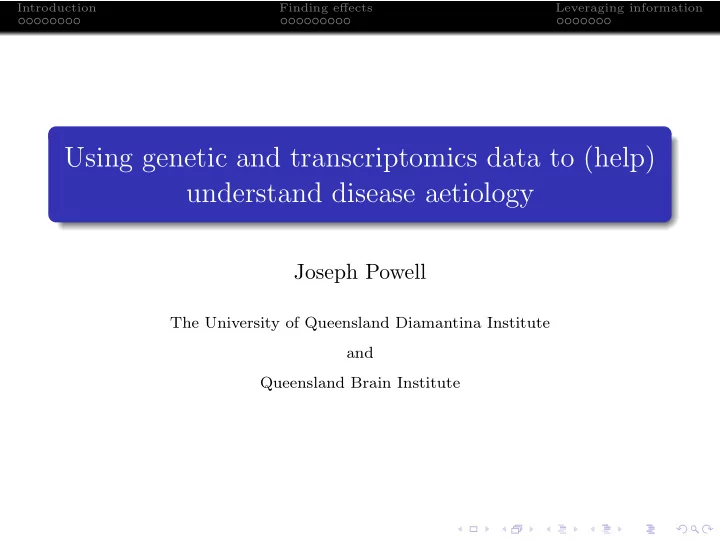

Introduction Finding effects Leveraging information Using genetic and transcriptomics data to (help) understand disease aetiology Joseph Powell The University of Queensland Diamantina Institute and Queensland Brain Institute
Introduction Finding effects Leveraging information Phenotypes
Introduction Finding effects Leveraging information Phenotypes
Introduction Finding effects Leveraging information Phenotypes
Introduction Finding effects Leveraging information Phenotypes
Introduction Finding effects Leveraging information Phenotypes
Introduction Finding effects Leveraging information Heritability σ 2 P = Phenotypic Variance σ 2 G = Genetic Variance σ 2 E = Environmental Variance σ 2 A = Additive Genetic Variance σ 2 P = σ 2 G + σ 2 E σ 2 D = Dominance Genetic Variance σ 2 G = σ 2 A + σ 2 D + σ 2 I σ 2 I = Interaction Genetic Variance H 2 = σ 2 G /σ 2 P h 2 = σ 2 A /σ 2 P
Introduction Finding effects Leveraging information Heritability
Introduction Finding effects Leveraging information Outline Genetic control of gene expression Differential gene expression eQTL Network analysis Additive and alternative Pathway analysis genetics GO term enrichment Leveraging eQTL and GWAS information
Introduction Finding effects Leveraging information Systems Genetics
Introduction Finding effects Leveraging information eQTLs
Introduction Finding effects Leveraging information Systems Genetics
Introduction Finding effects Leveraging information Starting simple
Introduction Finding effects Leveraging information GWAS / eQTL
Introduction Finding effects Leveraging information GWAS / eQTL
Introduction Finding effects Leveraging information GWAS / eQTL
Introduction Finding effects Leveraging information Additive Assumptions Additive Constant variance Extensions Covariates Multivariate Statistics Non-additive effects (dominance and interactions) y = µ + bx + e Variance heterogeneity
Introduction Finding effects Leveraging information Non-additive Re-parameterized linear or Double generalised linear logistic models models
Introduction Finding effects Leveraging information So you’ve done an eQTL analysis...
Introduction Finding effects Leveraging information Tissue specifc transcriptionally active regions
Introduction Finding effects Leveraging information Chromosome interactions
Introduction Finding effects Leveraging information SNP colocalisation with genomic features
Introduction Finding effects Leveraging information Phenotype - Expression Correlations Test statistical significance of the correlation Large number of tests Correlations due to genetic and environmental factors Correlate expression with phenotype
Introduction Finding effects Leveraging information Phenotype - Expression Correlations Null Hypothesis: expression is not correlated with the phenotype Statistical test for deviation in the p value distribution from null Select the top x percent of genes most correlated genes (Corr Regions) P-value distribution from the correlations
Introduction Finding effects Leveraging information Phenotype - Genotype Correlations What are the p values for SNPs in the Corr Regions? Are they different from non-correlated regions? If Pheno - Exp Cor are due to environmental factors SNP values distributions will be equal
Introduction Finding effects Leveraging information Acknowledgements Complex Trait Genomics Group Peter Visscher Naomi Wray Jian Yang Gib Hemani Anita Goldinger Collaborators Allan Mcrae Grant Montgomery (QIMR) Kostya Shakhbazov Nick Martin (QIMR) Hong Lee Greg Gibson (Georgia Tech) Qinggyi Zhao Manolis Dermitzakis (Uni of Geneva) Lude Franke (Uni of Groningen) Anna Vinkhuyzen Tim Spector (KCL) Guo-Bo Chen Beben Benyamin Kerrin Small (KCL) Gerhard Moser Visit us at Zong Zhang www.complextraitgenomics.com Zhihong Zhu Jake Gratten Marie-Jo Brion John Witte Lars Ronnegard
Recommend
More recommend